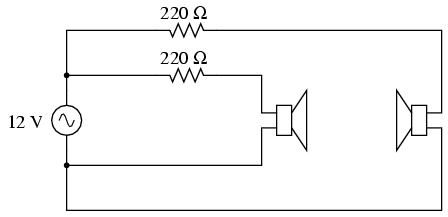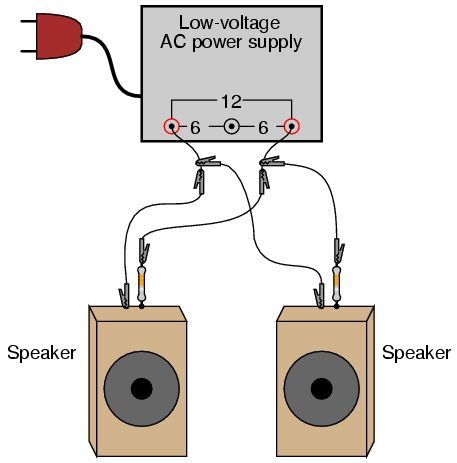Sound cancellation
PARTS AND MATERIALS
Large, low-frequency ("woofer") speakers are
most appropriate for this experiment. For optimum results,
the speakers should be identical and mounted in enclosures.
CROSS-REFERENCES
Lessons In Electric Circuits, Volume
2, chapter 1: "Basic AC Theory"
LEARNING OBJECTIVES
SCHEMATIC DIAGRAM

ILLUSTRATION

INSTRUCTIONS
Connect each speaker to the low-voltage AC
power supply through a 220 Ω resistor. The resistor limits
the amount of power delivered to each speaker by the power
supply. A low-pitched, 60-Hertz tone should be heard from
the speakers. If the tone sounds too loud, use higher-value
resistors.
With both speakers connected and producing
sound, position them so that they are only a foot or two
away, facing toward each other. Listen to the volume of the
60-Hertz tone. Now, reverse the connections (the "polarity")
of just one of the speakers and note the volume
again. Try switching the polarity of one speaker back and
forth from original to reversed, comparing volume levels
each way. What do you notice?
By reversing wire connections to one
speaker, you are reversing the phase of that
speaker's sound wave in reference to the other speaker. In
one mode, the sound waves will reinforce one another for a
strong volume. In the other mode, the sound waves will
destructively interfere, resulting in diminished volume.
This phenomenon is common to all wave events: sound
waves, electrical signals (voltage "waves"), waves in water,
and even light waves!
Multiple speakers in a stereo sound system
must be properly "phased" so that their respective sound
waves don't cancel each other, leaving less total sound
level for the listener(s) to hear. So, even in an AC system
where there really is no such thing as constant "polarity,"
the sequence of wire connections may make a significant
difference in system performance.
This principle of volume reduction by
destructive interference may be exploited for noise
cancellation. Such systems sample the waveform of the
ambient noise, then produce an identical sound signal 180o
out of phase with the noise. When the two sound signals
meet, they cancel each other out, ideally eliminating all
the noise. As one might guess, this is much easier
accomplished with noise sources of steady frequency and
amplitude. Cancellation of random, broad-spectrum noise is
very difficult, as some sort of signal-processing circuit
must sample the noise and generate precisely the right
amount of cancellation sound at just the right time in order
to be effective. |